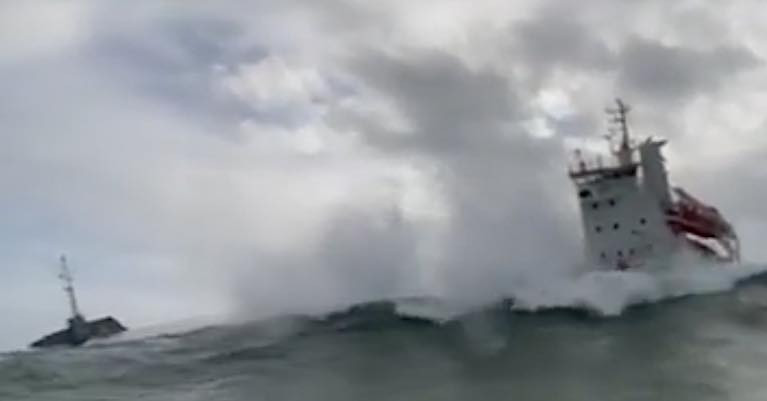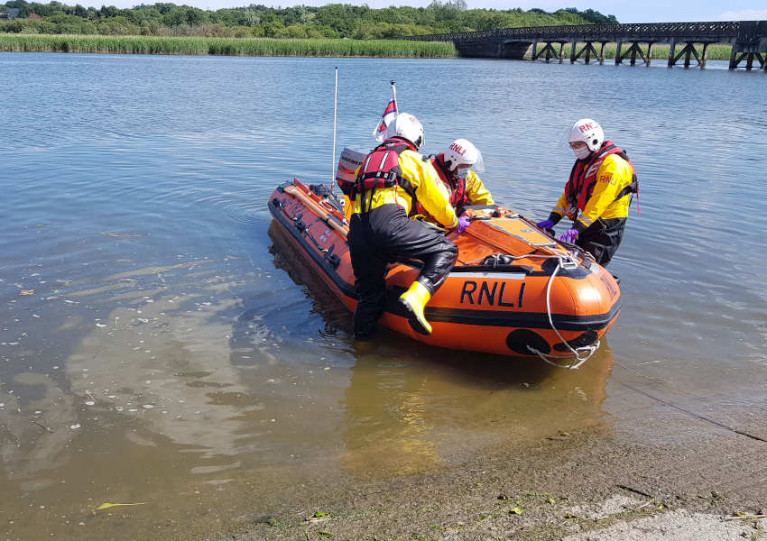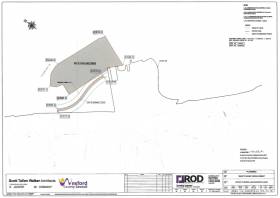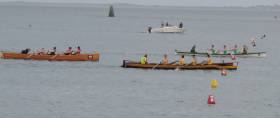Displaying items by tag: Wexford
Wexford Lifeboat Crew Member With 10 Years’ Experience Is Ready to Take the Helm This Christmas
Volunteering for the RNLI is truly a family affair for lifeboat crews in Co Wexford.
While Robbie Connolly is looking forward to his first Christmas on call since becoming a helm at Wexford RNLI earlier this year, his father-in-law Eugene Kehoe — a seasoned coxswain at Kilmore Quay — will also be ready to answer the call if there is an emergency at sea.
As the lifesaving charity continues its Christmas Appeal, Robbie and Eugene will skip their dinner for the difficult seas of winter should their pagers sound.
And they are urging people across Wexford — home to five stations at Courtown, Wexford, Kilmore Quay, Rosslare Harbour and Fethard — to help their crews, and the thousands of other volunteer crews on call over the Christmas period, to continue their lifesaving work.
“I am 10 years on the lifeboat crew at Wexford RNLI,” says Robbie, who is an engineer by day. “I have always had a love for the sea but when I finished college and started working alongside crew members and a deputy launching authority, I was encouraged to join, and I am delighted to be involved.”
As a helm, Robbie is responsible for the inshore lifeboat and his fellow crew during the launch of the lifeboat and while at sea.
“I have had one callout as helm so far and it was to a yacht with three people onboard that had got into difficulty on a falling tide and ran aground as it was coming into Wexford Harbour.
“Where our station is located, there are shifting sands and the channel is changing regularly so time was of the essence and with the callout happening at night, there was the added challenge of working in the dark. But thankfully, we had a safe and successful outcome.
“There are a few differences in being a helm,” he adds, “you are more conscious of looking after your own crew as well as those you are going to rescue and the conditions at sea.
“However, what my helm’s training taught me was to have more confidence in my decision making and skills ability and I suppose in that sense it is about having self-belief and making your 10 years of training and experience become second nature when responding to a callout.”
 Shane Crawford joins his brother Colum on the Aran Islands RNLI crew | Credit: RNLI
Shane Crawford joins his brother Colum on the Aran Islands RNLI crew | Credit: RNLI
Elsewhere, Aran Islands RNLI will have two new volunteer lifeboat crew on call, ready to drop everything and help launch the lifeboat to save those in trouble at sea.
Fisherman and father-of-five Georgie Gillan and NUIG student Shane Crawford are the most recent recruits to join the lifeboat.
Georgie says: “I’ve grown up around the sea and I’ve seen its power and its potential. I’m enjoying the training, and learning a different set of skills, all based around search and rescue and saving others.
“Being out on the lifeboat, you’re part of a team, the feeling of giving back is a great one. The standard of the kit and the training is so high and the support we get to do this job is amazing. I’m grateful to the people who support the work of the lifeboats and keep them at sea all year round.”
Meanwhile, Shane — a first year Arts student at NUIG Galway — knew from an early age that he would wear a lifeboat pager, as helping others is in his DNA.
His mother is the local community nurse and his father served with the local fire service for many years. Shane's older brother Colum is also a member of the Aran Islands RNLI volunteer lifeboat crew and is currently studying to become a paramedic.
Adding his support to the RNLI Christmas Appeal, Shane says: “It has been a dream for me to be on the lifeboat crew ever since I was very young. I feel very at home onboard the lifeboat even though I’m still new to it.
“The communication between the crew when we are out at sea is incredible and you can see the training and commitment of everyone involved. Every piece of kit has a purpose, and the RNLI are always looking to evolve and improve the equipment. It’s maintained to the highest standard and we are aware of the responsibility that comes with that.
“When the pagers goes, no lifeboat volunteer hesitates to answer the call, and these rescues would not be possible without the donations from the RNLI’s generous supporters, helping to fund the essential kit, training equipment needed by lifeboat crews all year round. Thank you to everyone who supports the appeal this Christmas.”
To make a donation to the RNLI’s Christmas Appeal, visit RNLI.org/Xmas
Three Rescued by Wexford RNLI After Powerboat Breaks Down
Wexford RNLI launched this morning (Wednesday 25 August) to rescue three people after their powerboat suffered engine failure.
The volunteer crew launched their inshore lifeboat at 10.12am and arrived at the scene to assess the situation five minutes later.
All three on board the powerboat were found to be in good health.
The lifeboat crew set up a tow and the three people were safely brought ashore at 10.27am with no injuries.
Weather conditions at the time were calm, with a Force 2 north-easterly wind and good visibility.
Speaking following the callout, Wexford RNLI press officer Lorraine Galvin said: “We would advise water users to ensure your boat equipment and engine are in good working order and to always carry a means of communication.
“If anyone sees anyone in difficulty on or near the water, ring 999/112 and ask for the coastguard.”
 Skerries RNLI approaching a small sailing vessel adrift off Lambay Island on Monday 23 August | Credit: RNLI/Gerry Canning
Skerries RNLI approaching a small sailing vessel adrift off Lambay Island on Monday 23 August | Credit: RNLI/Gerry Canning
Elsewhere on the East Coast, Skerries RNLI were tasked on Monday morning (23 August) to investigate reports of a raft adrift near Lambay island.
The raft reported by a fishing vessel in the area turned out to be a small sailing dinghy that had come adrift from a mooring somewhere.
With patches of heavy fog in the area, the boat presented a collision hazard to other vessels in the area so the decision was taken to bring it back to Skerries.
Speaking about the callout, Skerries RNLI press officer Gerry Canning said: “Thankfully there was nobody in trouble in this instance. However, the fishing vessel made the right call contacting the coastguard to report it.”
Dead Whale on Co Wexford beach ‘Most Likely to Be Minke’
The remains of a whale washed up on a Co Wexford beach are likely to be those of a minke whale, the Irish Whale and Dolphin Group (IWDG) says.
According to The Irish Times, the dead whale was discovered on Blackhall Strand in southwest Wexford yesterday morning, Sunday 13 June.
Going by its description, IWDG sightings officer Pádraig Whooley said it was most likely a minke whale. Wexford County Council said it was appraising the situation, and The Irish Times has more on the story HERE.
Meanwhile, the IWDG has just published a new guide on what to do when encountering a live-stranded whale, dolphin or porpoise.
Along with details on how to assess and care for the animal, Face to Face with a Beached Whale also includes practical information on dealing with other marine wildlife including turtles, seals, otters and seabirds.
A unique whale-shaped mosaic which is set for permanent public display aims to connect present-day Wexford with its storied maritime past, as RTÉ News reports.
With the help of artist Helen McLean, Wexford Arts Centre has been creating the patterned artwork from shards of Staffordshire pottery — known as ‘chanies’ — collected from the shore at Rosslare over many decades by local woman Ann Borg.
Many of these shards are believed to originate from the wreck of a US-bound ship that went down in Moran’s Bay in the 1850s.
They have now been used to create an impression of the blue whale that famously beached in Wexford in the 1890s — the skeleton of which now hangs inside the entrance of London’s Natural History Museum.
RTÉ News has much more on the story HERE.
Three RNLI Lifeboats Assist 4,000 Tonne Cargo Vessel in Danger of Hitting Rocks off Wexford Coast (Video)
RNLI lifeboat crews from Dunmore East, Kilmore Quay and Rosslare Harbour were requested to launch yesterday (Tuesday 20 October) after reports that a 4,000-tonne cargo vessel, the Lily B, had lost all power and was in danger of hitting rocks south of Hook Head in Wexford. The cargo vessel with a crew of nine onboard, was carrying coal when it lost power and came within a half a nautical mile of coming ashore on the Hook.
As Afloat reported yesterday, the call for help came in around 3pm when the Irish Coast Guard in Dublin requested lifeboats from Dunmore East, Kilmore Quay and Rosslare launch to the scene, just south of Hook Head in Wexford. The Coast Guard helicopter from Waterford, Rescue 117 was also tasked, monitoring from overhead and ready to assist with evacuation of the crew if needed.
 The Lily B cargo vessel had no power - Battling strong waves over six metres high, the three lifeboat crews worked together to ensure the cargo vessel stayed away from the rocks. See vid below.
The Lily B cargo vessel had no power - Battling strong waves over six metres high, the three lifeboat crews worked together to ensure the cargo vessel stayed away from the rocks. See vid below.
In force eight conditions, Dunmore East and Kilmore Quay RNLI established tow lines onto the drifting vessel which was then very close to the rocks. The two lifeboats maintained the tow and kept the cargo ship away from shore while a tug was en route from Waterford. Rosslare RNLI stood by.
Battling strong waves over six metres high, the three lifeboat crews worked together to ensure the cargo vessel stayed away from the rocks until the tow was passed to the tug on its arrival at 5.40pm. Escorting the vessels until they reached the calmer waters of Waterford Harbour in the early hours of Wednesday (21 October) the lifeboat crews were eventually stood down and returned to station.
Speaking on the callout Rosslare RNLI Lifeboat Operations Manager David Maloney said, ‘ If it wasn’t for the work of the three lifeboat crews out in force eight conditions I fear the vessel would have hit the rocks and there could have been a serious loss of life. The 4,000-tonne vessel came within a half a mile of the shore and Dunmore East and Kilmore Quay lifeboat crews had an incredibly difficult job in keeping it away from the rocks.
 The powerless Lily B was caught in big waves and came within half a mile of the Wexford shore
The powerless Lily B was caught in big waves and came within half a mile of the Wexford shore
‘The seas were huge, and it would not have been pleasant for anyone out there in those conditions. The lifeboat crews were out for over twelve hours in a callout that involved serious skill and concentration and I am tremendously proud of all three lifeboat crews involved. Thankfully we did not have a tragedy today.’
Wexford Lifeboat Rescues Five From Sinking Jet Ski
Wexford RNLI came to the rescue of five people on Monday afternoon (15 June) after the jet ski they were on lost power and began to sink.
The four teenagers and an adult had managed to get on top of a nearby pontoon on the River Slaney between Ferrycarrig Bridge and Killurin Bridge, where they then raised the alarm with the Irish Coast Guard.
Wexford RNLI volunteers were paged just before 3pm and launched the inshore lifeboat with three crew on board within 12 minutes.
Once on scene before 3.30pm, the crew took the four teenagers on board the lifeboat and brought them safely ashore at Killurin.
The lifeboat then returned to the scene for the adult and jet ski. Conditions at the time were good with no swell and a falling tide.
Speaking following the callout, Wexford RNLI helm Damien Foley said: “Everyone was wearing lifejackets and did the right thing by calling for help to the coastguard when they could.”
The volunteer crew of Damien Foley, Ger Doran and David Marskell, all of who were working at the time, were back at Wexford Lifeboat Station at 4.30pm. It was also the first rescue for volunteer crew member David Marskell.
Elsewhere on Monday, Aran Islands RNLI responded to two medevac shouts, on Inis Oírr and Inis Mór respectively, bringing two women to the mainland for treatment — one for a suspected broken arm.
Aran Islands lifeboat coxswain Declan Brannigan said: “Our volunteers didn't hesitate to answer both calls today and we would like to wish both women a speedy recovery.”
Wexford County Council has issued public notice of its application for a foreshore lease “for the purpose of land-based developments, a marina and a bridge/boardwalk”.
The newspaper advertisement published yesterday provides the location in Irish Transverse Mercator co-ordinates, which translate to Trinity Wharf on Wexford town’s waterfront.
Supporting documents propose a mixed-use urban quarter development totally 5.5 hectares and including the development of a 3.6 hectare brownfield site, a floating boom marina, sea wall and rock armour development, a bridge/boardwalk, a new access road and junction to Trinity Street, and ancillary works.
A copy of the application and relevant maps, plans and drawings are available for inspection for the next 20 working days, free of charge, at Wexford Garda Station on Mulgannon Road.
The advertisement also provides an incorrect link (as of this morning, Wednesday 26 June) to access the same documentation on the website for the Department of Housing, Planning and Local Government. The correct link is HERE.
Submissions will be received until close of business on Monday 22 July.
Flesk Valley and Workmen's Senior Champions at All Ireland Rowing
#CoastalRowing: The good results kept coming for Kerry clubs on the second day of the All Ireland Coastal Rowing Championships in Wexford. Flesk Valley won the senior men’s championship, while Workmen’s took the senior women’s crown. A Donegal club did break into the winning ranks. Cumann Rámhaíochta Chloich Cheann Fhaola (Cloughaneely CCF) had wins in women’s, men’s and mixed classes.
ICRF All Ireland Coastal Championships (Selected Results; winners):
Saturday
Men
Open Classic: Cloughaneely CCF
Celtic Longboats: Vartry A
Heritage: St Patrick’s. Under-18: Cromane
East Coast Skiffs: St Patrick’s. Under-16: Stella Maris
Under-21: Flesk Valley
Under-16: Fossa
Intermediate: Workmen’s.
Pre Veterans: Commercial, Killarney
Masters: Glenarm
Women
Celtic Longboats: Vartry
Heritage: St Patrick’s A. Under-18 Heritage: Cromane
Open Classic: Cloughaneely CCF
East Coast Skiffs: St Michael’s. Novice: Fingal
Under-21: Workmen’s
Intermediate: Workmen’s
Pre Veterans: Workmen’s
Mixed
Veteran: Workmen’s A
Sunday
Men
Senior: Flesk Valley
Currach: Cloughaneely CCF
Novice: Flesk Valley
Junior: Vartry
Under 18: Workmen’s
Veteran: Commercial, Killarney
Women
Senior: Workmen’s
Currach: Fergus
Novice: Cloughaneely CCF
Junior: Workmen’s
Under 18: Workmen’s
Under 16: Flesk Valley
Veteran: Sneem
Mixed
Senior: Vartry
Currach: Cloughaneely CCF
Pre-Vet: Workmen’s
Masters: Templenoe
Kerry Clubs Shine at All Ireland Coastal Rowing Championships
#CoastalRowing: Crews overcame sometimes difficult, windy, conditions at the big ICRF All Ireland Coastal Rowing Championships at Ferrybank in Wexford today. Kerry clubs did particularly well, with Flesk Valley, Cromane, Fossa, Workmen’s and Commercial all taking gold medals. The organisers of the event gave special awards to Mary B Teahan and Joe McAllister for their achievements in the organising of the event, given that there was a second Championships also taking place in Cork.
ICRF All Ireland Coastal Championships (Selected Results; winners):
Men
Open Classic: Cloughaneely CCF
Celtic Longboats: Vartry A
Heritage: St Patrick’s. Under-18: Cromane
East Coast Skiffs: St Patrick’s. Under-16: Stella Maris
Under-21: Flesk Valley
Under-16: Fossa
Intermediate: Workmen’s.
Pre Veterans: Commercial, Killarney
Masters: Glenarm
Women
Celtic Longboats: Vartry
Heritage: St Patrick’s A. Under-18 Heritage: Cromane
Open Classic: Cloughaneely CCF
East Coast Skiffs: St Michael’s. Novice: Fingal
Under-21: Workmen’s
Intermediate: Workmen’s
Pre Veterans: Workmen’s
Mixed
Veteran: Workmen’s A
Rowers Set for Coastal Rowing Championships
#Coastal Rowing: The inaugural Irish Coastal Rowing Championships will take place this Saturday and Sunday, August 18th and 19th at the National Rowing Centre in Farran Wood, Cork. Clubs from all four provinces are set to compete.
Eddie Farr, chair of the Coastal Championships Committee, said: “This is an incredibly proud moment in all our rowing lives, to at last get to row at our national and international rowing venue.”
The Championships, hosted by Rushbrooke Rowing Club, will see clubs race in over 30 different race categories, ranging from Under 12 to Masters, with race lengths ranging from 800 to 2,300 metres. Several thousand rowers and spectators are expected to attend the two day Championships.
The long-standing All Ireland Coastal Rowing Championships will also be held this weekend, from Friday to Sunday (August 17th to 19th) in Wexford. There will be an array of races in one-design Celtic boats, Currachs, East coast Skiffs, Wexford cots, Kerry four-oars, Donegal skiffs and Seine boats.































































